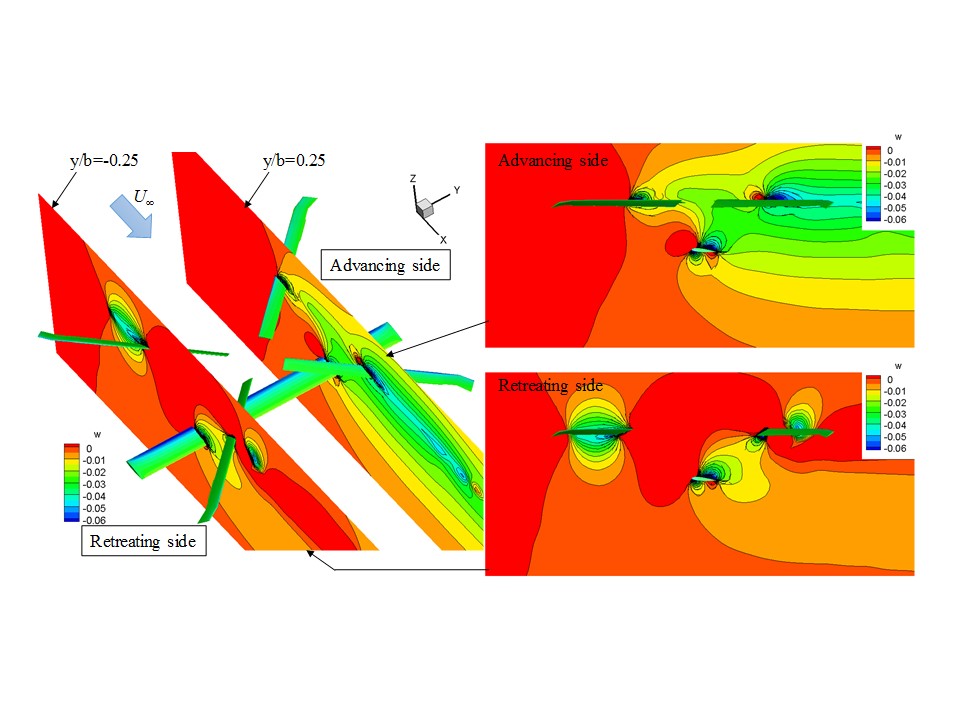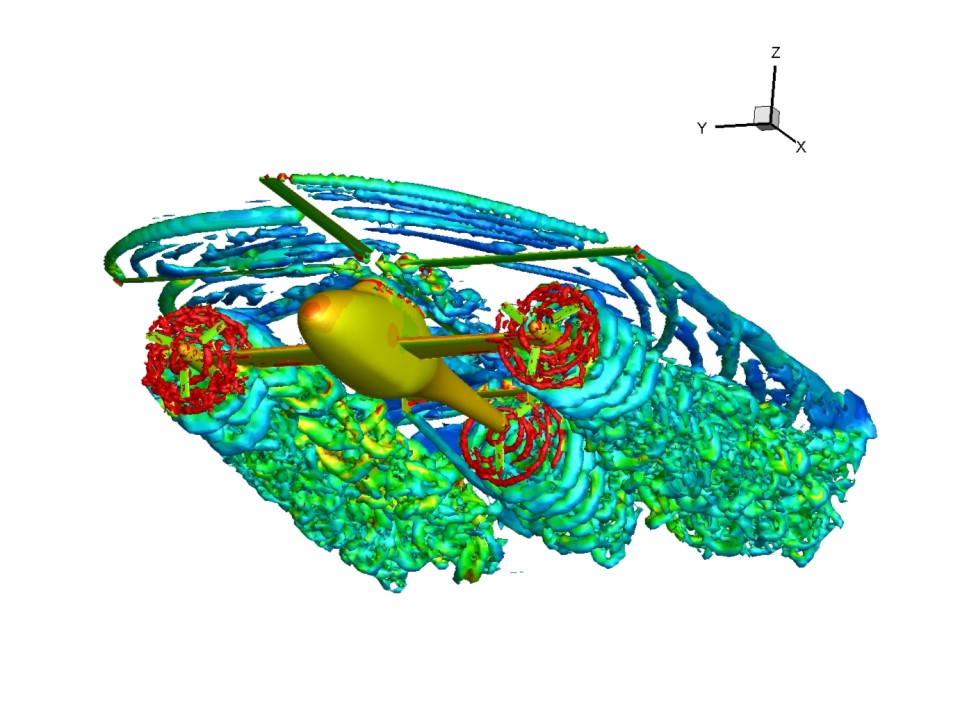Study of the Aerodynamic Interaction between the rotor and the wing on a compound helicopter
JAXA Supercomputer System Annual Report April 2017-March 2018
Report Number: R17EA3301
Subject Category: Aeronautical Technology
- Responsible Representative: Yasutada Tanabe, Aeronautical Technology Directorate, Next Generation Aeronautical Innovation Hub Center
- Contact Information: Yasutada Tanabe tanabe.yasutada@jaxa.jp
- Members: Masahiko Sugiura, Yasutada Tanabe, Hideaki Sugawara, Ryo Hayakawa
Abstract
A distinctive concept of compound helicopter is proposed by JAXA. Several key technologies have been recognized and investigated so far. Within them, the aerodynamic interaction between the main rotor and the wing may cause remarkable increase of the aerodynamic drag of the aircraft. With functional extensions of a CFD code for rotorcraft, rFlow3D, the interaction is simulated under same lift condition during high speed flight. Designs of optimal low drag wing and rotor are the final goals of this research.
Reference URL
Please refer to ‘Future type rotary-airfoil airplane system technology | Sky Frontier – Sky Frontier Program | Aeronautical Technology Directorate‘.
Reasons for using JSS2
The flowfield around a compound helicopter is very complicated because of the existence of multiple rotors and complex fuselage. It is required to assign a large amount of computational grid points around the aircraft. Also with the rotating blades, the flowfield is intrinsically unsteady and need a long time of CPU hours. The JSS2 supercomputer with abundant computing resources is absolutely neccessary for this research.
Achievements of the Year
Referred to the geometry of the main rotor blade of an existing helicopter, UH-60A, where published wind tunnel testing data are available, a rectangular fixed wing is placed under the rotor. At high advance ratio flight, due to the aerodynamic interaction between the main rotor and the wing, the aerodynamic drag of the combined rotor and wing increased about 20% compared to the combination of an isolated rotor and an isolated wing with same lift. A sample of the flowfield around a full configuration compound helicopter is shown in Figure 1. The flowfield on the advancing side and on the retreating side of the rotor is shown in Figure 2 illustrating the interaction between a rotor and a wing.

Fig.2: Rotor/Wing interaction flowfield on the advancing side and on the retreating side of the rotor
Publications
■ Peer-reviewed papers
1) Atthaphon Ariyarit, Masahiko Sugiura, Tanabe Yasutada, Masahiro Kanazaki, “Hybrid surrogate-model-based multi-fidelity efficient global optimization applied to helicopter blade design,” Engineering Optimization, Taylor & Francis, pp. 1-25, Sept. 2017.
■ Non peer-reviewed papers
1) Masahiko Sugiura , Yasutada Tanabe , Hideaki Sugawara, George N. Barakos , Naoki Matayoshi , Hirokazu Ishii, ” Validation of CFD Codes for the Helicopter Wake in Ground Effect,” 43rd European Rotorcraft Forum, Sep. 13, 2017, Milano, Italy.
2) Masahiko Sugiura, Yasutada Tanabe, Hideaki Sugawara, “Optimal Aerodynamic Design of Main Rotor Blade for a High-Speed Compound Helicopter,” 6th Asian-Australian Rotorcraft Forum & Heli Japan 2017, November 7-9, 2017, Kanazawa, Japan.
3) Hideaki Sugawara, Yasutada Tanabe, “A Study of Rotor/Wing Aerodynamic Interaction at High Speed Flight on a Compound Helicopter,” 6th Asian-Australian Rotorcraft Forum & Heli Japan 2017, November 7-9, 2017, Kanazawa, Japan.
4) Gunther Wilke, Annika Moller-Langer, Yasutada Tanabe, Masahiko Sugiura, Hideaki Sugawara, “Tackling the HARTII test case: A joint effort by DLR and JAXA,” 6th Asian-Australian Rotorcraft Forum & Heli Japan 2017, November 7-9, 2017, Kanazawa, Japan.
5) Koichi Yonezawa, Tomoki Kagayama, Shigeru Sunada, Kazuyasu Sugiyama, Noboru Kobiki, Yasutada Tanabe, Masahiko Sugiura, Takashi Aoyama, ” An Experimental Study of Aerodynamics of a Compound Helicopter,” 6th Asian-Australian Rotorcraft Forum & Heli Japan 2017, November 7-9, 2017, Kanazawa, Japan.
6) Yusuke Hamamoto, Takeshi Akasaka, Yasutada Tanabe, “Experimental Investigation of the Rotor-Wing Aerodynamic Interaction on a Compound Helicopter in High Advance Ratio,” 6th Asian-Australian Rotorcraft Forum & Heli Japan 2017, November 7-9, 2017, Kanazawa, Japan.
7) Keiichiro Makino, Takeshi Akasaka, Yusuke Hamamoto, Masatoshi Inaba, Yasutada Tanabe, “Experimental Investigation of the Rotor-Wing Aerodynamic Interaction on a Compound Helicopter in Hover,” 6th Asian-Australian Rotorcraft Forum & Heli Japan 2017, November 7-9, 2017, Kanazawa, Japan.
Usage of JSS2
Computational Information
- Process Parallelization Methods: N/A
- Thread Parallelization Methods: OpenMP
- Number of Processes: 1
- Elapsed Time per Case: 360.00 hours
Resources Used
Fraction of Usage in Total Resources*1(%): 0.46
Details
Please refer to System Configuration of JSS2 for the system configuration and major specifications of JSS2.
| System Name | Amount of Core Time(core x hours) | Fraction of Usage*2(%) |
|---|---|---|
| SORA-MA | 2,566,629.41 | 0.34 |
| SORA-PP | 215,684.86 | 2.70 |
| SORA-LM | 0.00 | 0.00 |
| SORA-TPP | 3,579.92 | 0.40 |
| File System Name | Storage Assigned(GiB) | Fraction of Usage*2(%) |
|---|---|---|
| /home | 271.40 | 0.19 |
| /data | 17,050.12 | 0.32 |
| /ltmp | 3,011.07 | 0.23 |
| Archiver Name | Storage Used(TiB) | Fraction of Usage*2(%) |
|---|---|---|
| J-SPACE | 0.00 | 0.00 |
*1: Fraction of Usage in Total Resources: Weighted average of three resource types (Computing, File System, and Archiver).
*2: Fraction of Usage:Percentage of usage relative to each resource used in one year.
JAXA Supercomputer System Annual Report April 2017-March 2018



